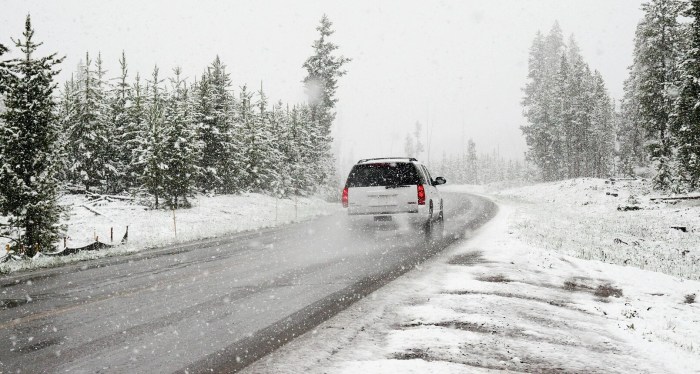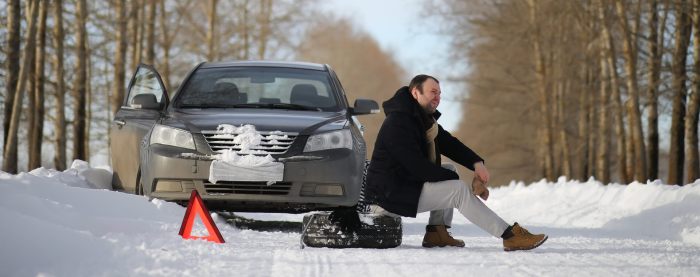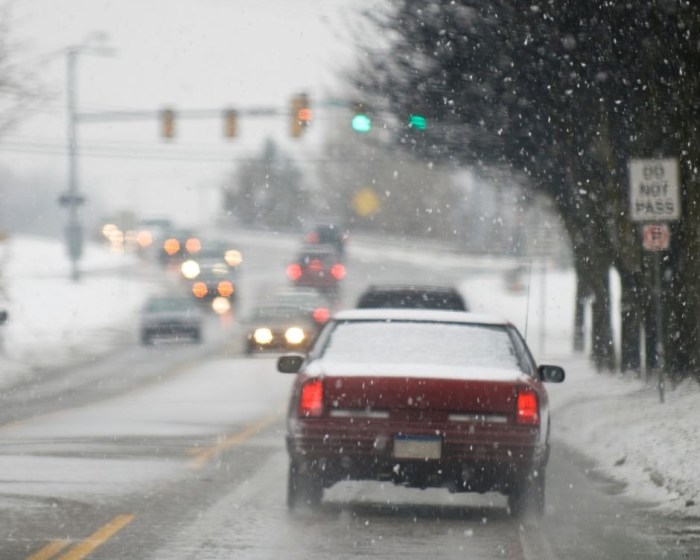Best car insurance for driving in harsh winter conditions is crucial for protecting yourself and your vehicle during the challenging winter months. Navigating icy roads and snow-covered streets presents unique risks, making comprehensive coverage essential. This guide explores the vital aspects of securing the right insurance, from understanding necessary coverage levels to identifying factors influencing premiums and leveraging safety features to your advantage.
We’ll equip you with the knowledge to make informed decisions and secure peace of mind on winter roads.
Understanding the nuances of winter car insurance involves considering various factors beyond standard coverage. Geographic location significantly impacts premiums, as areas with heavy snowfall and frequent icy conditions naturally command higher rates. Your driving history, particularly accidents occurring during winter, also plays a crucial role. The type of vehicle you drive—all-wheel drive or four-wheel drive vehicles often receive more favorable rates—influences your premiums.
Furthermore, safety features such as anti-lock brakes and advanced driver-assistance systems can lead to significant cost savings through discounts.
Essential Coverage for Winter Driving
Navigating winter roads presents unique challenges, demanding comprehensive insurance coverage to protect against potential mishaps. Understanding the crucial aspects of your policy is paramount to ensuring financial security during harsh winter conditions.
Comprehensive and Collision Coverage for Winter Damage
Comprehensive coverage protects against damage caused by events outside your control, such as hail, falling trees, or even damage from accumulating snow and ice. Collision coverage, on the other hand, covers damage resulting from accidents, regardless of fault. In winter, these coverages become especially important. A collision with a patch of black ice or damage from a falling icicle could result in significant repair costs, readily covered by these policies.
Uninsured/Underinsured Motorist Coverage in Icy Conditions
Uninsured/underinsured motorist (UM/UIM) coverage is critical in any driving environment, but its importance is amplified during winter. Icy roads increase the likelihood of accidents, and unfortunately, some drivers may be uninsured or underinsured. UM/UIM coverage safeguards you financially if you’re involved in an accident caused by an uninsured or underinsured driver.
Roadside Assistance in Winter Storms
Roadside assistance is a valuable addition to your car insurance policy, particularly during winter. Situations such as getting stuck in snow, experiencing a flat tire in freezing temperatures, or running out of gas in a blizzard can quickly become dangerous. Roadside assistance provides crucial support, offering towing, battery jump-starts, and other emergency services.
Comparison of Coverage Levels and Winter Driving Relevance
| Coverage Type | Description | Winter Driving Relevance | Example Scenario |
|---|---|---|---|
| Liability | Covers damage or injury to others | Essential, regardless of weather | Accident causing injury to another driver |
| Collision | Covers damage to your vehicle in an accident | Highly relevant; protects against ice/snow accidents | Damage from hitting a patch of black ice |
| Comprehensive | Covers damage from non-collision events | Highly relevant; protects against hail, falling objects | Damage from a falling tree branch |
| Roadside Assistance | Emergency services like towing and jump starts | Crucial in winter; helps with snow/ice related issues | Getting stuck in a snowdrift |
Factors Affecting Insurance Premiums in Winter Climates: Best Car Insurance For Driving In Harsh Winter Conditions
Several factors influence your car insurance premiums, especially in areas with harsh winters. Understanding these factors can help you make informed decisions about your coverage and potentially save money.
Geographic Location and Insurance Rates

Your location significantly impacts your insurance rates. Areas with frequent heavy snowfall, icy roads, and higher accident rates during winter will generally have higher premiums. Insurance companies assess risk based on historical claims data in specific regions.
Driving History and Winter Accidents
Your driving history, particularly any accidents or violations that occurred during winter conditions, directly affects your premiums. Insurance companies consider this a high-risk factor, leading to increased rates. Maintaining a clean driving record, especially during winter months, is crucial for keeping premiums low.
Insurance Rates for Different Vehicle Types
The type of vehicle you drive also plays a role in your insurance costs. All-wheel drive (AWD) and four-wheel drive (4WD) vehicles are generally considered safer in winter conditions, potentially leading to lower premiums compared to two-wheel drive vehicles. However, the specific make, model, and safety features of the vehicle also contribute to the final premium.
Impact of Various Factors on Insurance Costs
| Factor | Impact on Premiums | Example | Mitigation Strategy |
|---|---|---|---|
| Geographic Location (High Snowfall) | Higher Premiums | Living in a mountainous region | Consider moving to a lower-risk area (if possible) |
| Winter Accidents | Higher Premiums | Multiple accidents during winter months | Defensive winter driving techniques |
| Vehicle Type (2WD vs. AWD) | 2WD higher, AWD lower | Sedan vs. SUV with AWD | Choose a vehicle with better winter capabilities |
| Driving Record | Clean record = lower premiums | No accidents or violations | Safe driving practices |
Winter Driving Safety Features and Their Impact on Insurance
Modern vehicles are equipped with a range of safety features that enhance winter driving safety and can influence your insurance premiums. These features demonstrate a commitment to safety, potentially resulting in discounts.
Role of Anti-lock Brakes (ABS) and Traction Control
ABS prevents wheel lockup during braking, crucial on icy roads, enhancing control and reducing the risk of skidding. Traction control systems help maintain traction by reducing wheel spin, improving stability and preventing loss of control. These features significantly reduce accident risk and are often rewarded with lower insurance rates.
Advanced Driver-Assistance Systems (ADAS) and Insurance Premiums
ADAS features like lane departure warning, adaptive cruise control, and automatic emergency braking (AEB) further enhance safety, especially in challenging winter conditions. Insurance companies often offer discounts for vehicles equipped with these advanced safety technologies because they significantly reduce the likelihood of accidents.
Insurance Discounts for Winter-Specific Safety Features
Many insurers offer discounts for vehicles with features specifically designed for winter driving, such as heated seats and steering wheels, improved tire pressure monitoring systems, and all-wheel or four-wheel drive systems. These discounts incentivize drivers to choose vehicles better equipped for winter conditions.
Cost Savings Associated with Safety Features
- Anti-lock Brakes (ABS): Potential reduction of 5-10% in premiums.
- Traction Control: Potential reduction of 5-10% in premiums.
- Automatic Emergency Braking (AEB): Potential reduction of 10-15% in premiums.
- All-Wheel Drive (AWD) or Four-Wheel Drive (4WD): Potential reduction of 5-10% in premiums.
Finding the Best Policy for Winter Driving Needs
Securing the best car insurance policy for winter driving involves careful comparison and consideration of your specific needs and risk profile.
Comparing Car Insurance Quotes
Obtain quotes from multiple insurers. Use online comparison tools or contact insurers directly to gather quotes. Compare coverage options, premiums, and deductibles to find the best value for your needs. Consider factors such as your driving history, vehicle type, and location.
Obtaining Multiple Quotes and Identifying Best Value
Don’t settle for the first quote you receive. Shop around and compare at least three to five quotes to ensure you’re getting the most competitive rate. Pay close attention to the coverage provided, not just the premium. The cheapest policy might not offer the necessary protection for winter driving.
Reading Policy Documents Carefully
Before committing to a policy, read the policy documents thoroughly. Understand the terms and conditions, coverage limits, exclusions, and any additional fees. If anything is unclear, contact the insurer for clarification before signing.
Checklist of Questions for Insurance Providers
- What specific coverage do you offer for winter-related damages?
- What is your process for handling claims related to winter accidents?
- Do you offer discounts for vehicles with winter safety features?
- What is the deductible for collision and comprehensive coverage?
- What is included in your roadside assistance package?
Illustrative Examples of Winter Driving Incidents and Insurance Claims

Real-life scenarios illustrate the importance of adequate insurance coverage during winter. These examples highlight the potential costs and the role insurance plays in mitigating financial burdens.
Collision Due to Black Ice, Best car insurance for driving in harsh winter conditions
Imagine a driver loses control on a patch of black ice, resulting in a collision with another vehicle. The damage to both vehicles is significant. Collision coverage would cover the repair costs to the driver’s vehicle, while liability coverage would cover damages to the other vehicle and any injuries sustained. Comprehensive coverage might also be relevant if there is additional damage beyond the collision itself.
Roadside Assistance Due to Snow
A driver gets stuck in a snowdrift during a blizzard. Roadside assistance is called to tow the vehicle to a safe location. The cost of towing and any related expenses are covered by the roadside assistance portion of the insurance policy.
Damage from Falling Ice
A large chunk of ice falls from a building onto a parked car, causing significant damage to the vehicle’s roof and windshield. Comprehensive coverage would cover the repair or replacement costs.
Comprehensive Coverage During a Winter Storm

A severe winter storm causes extensive damage to a vehicle, including broken windows and flooding due to heavy snow accumulation. Comprehensive coverage would pay for the repairs, covering damage from events outside the driver’s control.
FAQ Summary
What is the difference between comprehensive and collision coverage?
Comprehensive covers damage from events outside your control (e.g., hail, falling objects), while collision covers damage from accidents.
How does my credit score affect my car insurance rates?
In many states, your credit score is a factor in determining your insurance premiums. A higher credit score often translates to lower rates.
Can I get a discount for taking a defensive driving course?
Many insurance companies offer discounts for completing a certified defensive driving course. Check with your provider.
What should I do if I’m involved in a winter accident?
Ensure everyone is safe. Call emergency services if needed. Document the accident with photos and exchange information with other drivers. Contact your insurance company immediately.